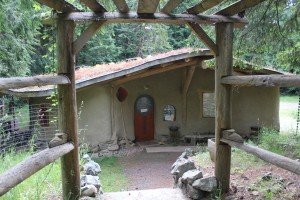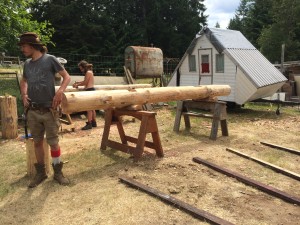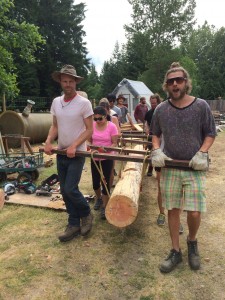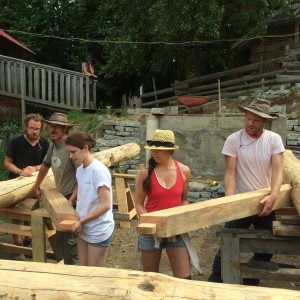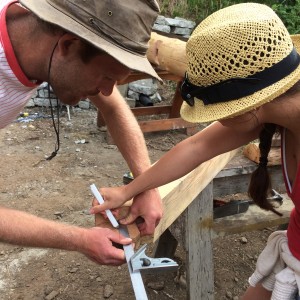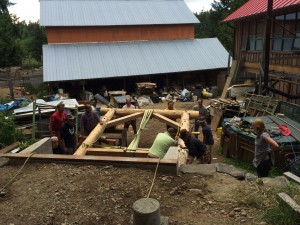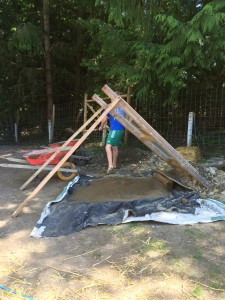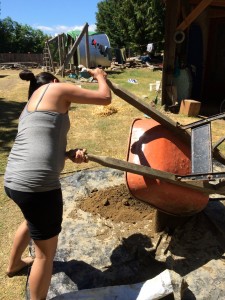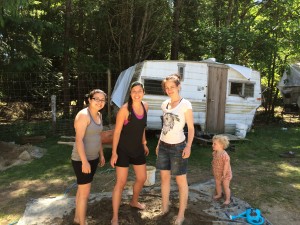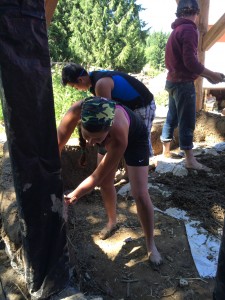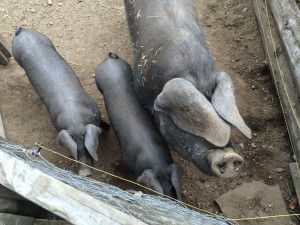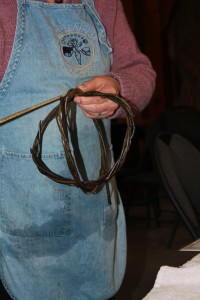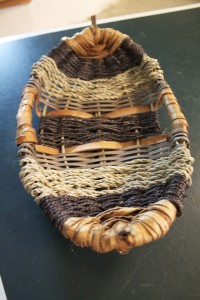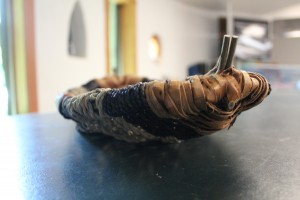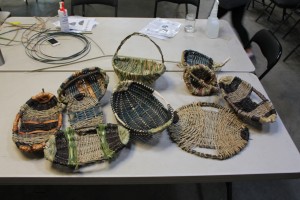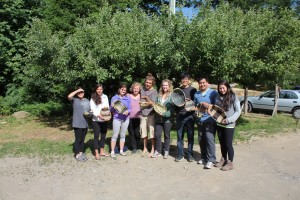First Week At A Glance! What an incredible experience so far! We arrived at the Ecovillage, being the first ones from our UBC group to get there, and our host, Brandy Gallagher, happily greeted us. She was so warm and friendly with an incredible smile, happy to see us. We were immediately introduced to a few community members who were in the process of stripping cedar for basket making and asked if we would like to take part in the process. Talk about hands on learning! I jumped at the opportunity, and started removing the outer bark layer from the planks that were previous stripped from the cedar trees located beside us. We were then educated on the process of making baskets and hats from the cedar stripping technique and process to the steps of drying and prepping the strips for use in weaving. This was an incredible introduction to what we would be experiencing at this placement! Materials are locally grown and harvested to then prepared in the most natural and environmentally friendly manner. The finished product is used, and reused or brought back to the earth to degrade into its most basic original form.
What an incredible experience so far! We arrived at the Ecovillage, being the first ones from our UBC group to get there, and our host, Brandy Gallagher, happily greeted us. She was so warm and friendly with an incredible smile, happy to see us. We were immediately introduced to a few community members who were in the process of stripping cedar for basket making and asked if we would like to take part in the process. Talk about hands on learning! I jumped at the opportunity, and started removing the outer bark layer from the planks that were previous stripped from the cedar trees located beside us. We were then educated on the process of making baskets and hats from the cedar stripping technique and process to the steps of drying and prepping the strips for use in weaving. This was an incredible introduction to what we would be experiencing at this placement! Materials are locally grown and harvested to then prepared in the most natural and environmentally friendly manner. The finished product is used, and reused or brought back to the earth to degrade into its most basic original form.
This week has been incredibly engaging through a variety of activities including an education tour of the village grounds, gardening education, replanting plants, weeding the gardening beds, compost education, assisting in building construction, preparing the CSA (community supportive agriculture) boxes, and participating as part of the community in heart circles, women circles, yoga classes and village cleaning/kitchen preparation jobs.
The community vibe in the village is one of inclusivity, love and respect. Everyone here is so friendly, welcoming and supportive. After only knowing the community members for 24 hours, I became comfortable with sharing with them my personal experiences, cry with them doing heartfelt moments, and have felt as if I am living with family. Before every Heart Circle or Community Meeting the group takes part in a grounding activity through meditation, stretching and calm time. A Check-in is then done with each community member to see how he or she is feeling inside. This can take place through the use of weather metaphors or a description of your feelings and why. The pattern used for speaking is in a counter-clockwise direction, the way of the earth. A talking object is also used during Heart Circles and community meetings when speaking. These heart circles are also opportunities for people in the community to express feelings about any tension with other members or any negativity felt in the village. This is very important at the Ecovillage, for it is believed that keeping things inside is unhealthy for everyone involved.
A challenge that I have encountered during this first week revolves around the drastic change in pace that I have experienced at the Ecovillage compared to what I am so used to in an urban setting, in UBC classes and during placement. The atmosphere here is one of relaxation, and is slow paced and laid back. Coming back from practicum, it has been hard to not have an idea of what is going to happen during the day or what activities we will be apart of. As the week has progressed, I have learned to become far less stressed about a schedule and more accepting of not knowing what is to come and taking each experience to the fullest as they come.
I have learned so much this week already that I never have been exposed to. I have lived in a very urbanized setting all my life and a lot of the educational aspects in the Ecovillage have never been presented to me in my entire educational and personal life experiences. I have learned about gardening techniques like lasagna mulching, transfer ditches and their required 10 degree angle to provide ample water to vegetables. I have also learned about Solar yoga body mapping and how it can assist in the design and building of a home with respect to the sun exposure and the seasons. I have been exposed to some fascinating plants and extraordinary ecologically friendly means of building, such as the use of COB ( a natural building material made from clay water, sand, earth, and organic material like straw or wood chips). This is just a taste of some of the educational aspects I have been exposed to that could be incorporated into any grade classroom.
The hands on way of learning here is similar to the Reggio Emilia Approach I was exposed to and taught in my practicum experience, so I feel that this opportunity will continue to enhance my understanding of this style of teaching. It is so amazing to learn how things are created from the initial stages and to be apart of the process of creating to completion. The pedagogical processes that I have learned throughout my UBC experience are fully aligned with the principle teachings seen at O.U.R. Ecovillage. A part of me never wants to leave and I cannot wait to experience more!
Community
The community atmosphere of the Ecovillage is one of inclusivity, respect, and fosters immense connection between the people who make up the community. From day 1 I was told that from the moment I stepped onto the Ecovillage premisis I am considered a community member, not a guest of the village. This concept is so incredibly important in any environment, especially within the school and classroom community. I felt so welcomed as another family member of this community, and it made me feel so comfortable in a very foreign and new environment. I have yet to ever feel alienated, or below another individual. Each member of this community is equally teaching and equally learning from one another, the spiral of learning and teaching is continuous whether you have been at the Ecovillage for one day or for one year. This approach to education, by seeing the students and teachers as a unified body of intelligent people who both learn, teach, and relearn from each other, is very similar to the Reggio Emilia approach I experienced in my practicum class and one that I will highly advocate during my teaching career. Experiencing the community bond at the Ecovillage first hand has allowed me to see how a child could potentially feel in a very new, and unknown classroom with new faces and new sights. The community I experienced in both my practicum and the Ecovillage has solidified a desirable environment that I will continuously strive to achieve in my own future classrooms.
Some community concepts learned from the Ecovillage:
– Curiosity brings acceptance, understanding and love.
– Using “I” statements is important when sharing feelings with others vs “you made me feel…”. It brings about a very calm environment for discussing conflicts and removes an attack on the individual, while focusing on the individual’s behaviour. This shares awareness of how actions affects different people
– Once a week council happens. This is a very intimate group gathering of community members where trust and understanding is built.
– Honouring circle for community members who leave the Ecovillage where the individual is celebrated through praise, discussion of good times and fond memories, and wishes for the future.
– CSA boxes – (Community Support Agriculture) is an initiative to promote farmer collaboration and local food production, thus interacting with, and working alongside, the local community and greater public through sharing of skills, and product.
Sustainable Building
The buildings at the Ecovillage are extremely unique! I have never before seen a structure built with such character in its exterior and interior design and such unique building materials.
The buildings at the Ecovillage are built out of Cob, a material consisting of a mixture of clay, sand, water and a binder of wood chips or straw. It is a very versatile building material that can be sculpted and moulding into beautiful artistic structures. The price for the materials is also very minimal, for all of the materials can be dug from the village grounds. The sand is used as the aggregate, similar to concrete, and provides strength to the walls. The straw helps resist against cracking and provides strength as well. The clay binds the whole mixture.
We got the amazing experience of working alongside the builders by helping with mixing the cob ingredients together and forming the thermal walls of a new washroom that was being built during our stay.
The washroom was a timber framed structure that had posts and trusts (beams and rafters). It was such a great opportunity to both witness the building of these beams and assisting in putting the structure together.
We mixed the cob ingredients in a manner that our ancestor builders used, stomping and mixing with the feet and rolling the mixture in a tarp. This experience was so much fun, brought the kid out in me, and I greatly connected with the earth and nature as I used my feet! The sand and clay were sifted to remove any rocks, then eight scopes of sand, eight scopes of clay, some water and straw would be added on top of a tarp. It was then stomped on with our feet, continuously adding water and straw until the right consistency developed. The tarp would be used to create a roll called a “cob burrito” and then wheel barrelled to the construction site.
Handfuls of the material where added to the foundation and the angles and wall shapes were formed with our hands. The maximum height of the walls per day could be no more than a foot of height, for the walls need to settle and dry and this would limit the wall from sagging.
Once a wall is completed it is plastered with clay to create a smooth finish. Gemstones, glass, tiles and personal artefacts can be placed within the walls to provide a beautiful look but also to include some personal and memorable momentous of the builders.
The educational aspect that really stood out for me was the thermal properties of cob. The walls absorb heat energy from the sun and the walls have the capacity to “breathe”, acting as a natural form of air conditioning in the summer and a nature ability to warm a house through heat accumulation during the winter. Cob can also be used to make baking ovens for pizza and bread and have been used to help assist in the garden. There is a citrus house built in the garden out of cob that has a thick cob north facing wall and a glass south facing wall. The thermal mass of the cob walls allow for heat accumulation from the sun and energy transfer within the citrus house that will create an optimal environment for growing citrus fruits. This eliminates the need for electricity in heat lamps and building materials that could be toxic and unsustainable in the future. When building a house or any structure at the Ecovillage the builders use a concept called solar body mapping to determine the angles of the sun setting in winter, summer and the equinox. This helps to fully utilize the sun’s heat in heating the building.
This sustainable building experience can be successfully introduced into any classroom and any grade level. Again, the introduction of building concepts to students that are more natural can link environmental study lesson plans of recycling and reusing as well as scientific lessons on properties of earth matter like clay and sand. Lessons on social responsibility and social studies can be a means of guiding students in becoming more environmentally conscious. Students can become great inquirers and critical thinkers by taking this building method and applying it to building items, objects and structures that are important in their personal lives and community. The hands on experience allows students to become fully immersed in the entire process from start to finish and develop not only a greater appreciation for quality work but also the feeling of accomplishment of working hard at something with there own hands and feet. Play is also incorporated in this process, which I feel is crucial aspect in any child’s learning.
Animals
The animals at the Ecovillage have been a pleasure to have around! After living in the Ecovillage for a couple weeks I have begun to really enjoy their sounds and company.
May I introduce you to Violet, the calf that lives amongst the sheep! Her mother died when she was very young so she has been raised alongside the many sheep at the village and we have learned to believe that she has a bit of identity confusion with what kind of animal she is. Violet loves to roam in the fields amongst the sheep but also really enjoys being petted, scratched and hugged. A common saying at the village is “pet a cow a day and your stress goes away!” She is a gentle soul, and a true sweet heart of a creature.

The hens on the farm produce between 2 to a dozen eggs a day! Some chickens have been killed on the farm and the village is still investigating who the culprit may be. When a chicken is found dead it is buried deep within the compost bin and it decomposes there to become apart of the compost on site. Here are the Roosters!
The pigs on the farm are quite amusing! Pigs are incredibly intelligent creatures! There is one very large mother pig and two piglets! I find it so adorable and funny that their ears hang right over their eyes and completely cover their vision – who knew pigs were naturally equipped with their very own effective sunglasses! Feeding the pigs have been a real treat as well!
The cutest kittens have lived under the stairs of our residence during our stay! Watching them learn how to walk has brought much pleasure, they are very adorable! I wonder if anyone in our UBC group will bring one home!
Lastly, the wild turkeys….Did you know turkeys FLY?! I was very much surprised one day when I met up with a turkey sitting on a fence, that was elevated above me by a hill, and it took off and flew right over my head, using the slope and hight of the perch for its take-off. Incredible with their body mass! What shocked me even more was when I saw wild turkeys in the trees…hoping from branch to branch!
Basket Weaving!
This week we had the fabulous chance to take part in a basket weaving class! I absolutely love crafts and the urge to create things from start to finish has been greatly enhanced at the Ecovillage. I have been overwhelmed with the feeling of wanting to ask more questions, engaging myself to a more fuller extent in the processes and becoming a greater inquirer than I was before. I believe that this is manifesting from the vast amount of hands on experiences being offered at the Ecovillage and the accessibility to knowledgeable people and resources so that I can experiment in my own way with a variety of activities. This is how information is retained, and how students actually become interested and invested in their own learning. This is how a student becomes an inquirer and critical thinker.
Basket weaving was taught by Maria Curtis, a basket weaver who owns Raven’s Joy Basketry. A key feature of the Ecovillage’s education program that I will strive to do as a teacher is the constant incorporation of the community. Maria brought prototype baskets for us to view and provided us with an instructional package on how to basket weave, which I was super excited about for it will help me when I potentially decide to teach basket weaving to a future class. She explained that there are three to four different types of baskets: Splint, Wicker, Coiling and Rib. We were going to be making Rib baskets where rings would be created as the structural components and the frame would be further enhanced with spokes. All materials are soaked in water to allow them to be pliable enough to bend and shape.
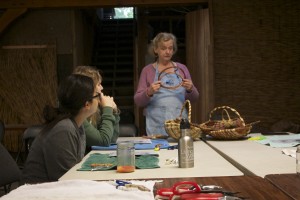
Step 1: Build the Rings
The rings were built using whillow branches from a local forest that were harvested and dried. I bent and twisted the branches around each other until I got my desired size, shape, and and thickness of ring. If the basket was going to have a handle, two rings were created to form the basic structure, however, I wanted to make a low basket without a handle so I only made one ring.
Step 2: Lash spokes to ring
A base spoke was created using two rods, twisted together to build strength, and bent to create the desired depth of the base of the basket. This was then lashed to the main ring. There are a variety of methods to lash hoops and rods together and the one I used for this basket is called “X-lashing”. I really gravitated to the cedar strips as a material to incorporate into my basket because of my previous cedar plank preparation experience at the Ecovillage (I wanted to continue that experience into creating a product). The thickness of the cedar also worked really well for the lashing and even though Maria was an expert at basket weaving she too experienced some moments of exploration, emphasizing the continual spiral of learning that occurs when perfecting a skill and expanding a knowledge area.
We were given the opportunity to choose a variety of materials, and make what ever our hearts desired. I wanted to make something that would be useful in my personal life and I wanted to experiment with a variety of materials to stretch my capabilities.
Step 3: Inserting Ribs into X lashings
This was a bit trickier for me because I used the cedar strips and the thickness of the strips combined with the tight weaving made it difficult to find openings to place the ribs. I used a few tools to help me create openings in the lashing and played with the positioning of the ribs until the basket sat properly on a table.
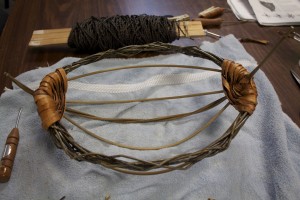
Step 4: Packing
This is the fun part after all the ribs are in place! I chose a variety of cordage, some made from local cattails dried and woven. I am really happy to say that some of the cordage used in my basket was created at the Ecovillage by the community members I have grown to love. I am so happy to be able to bring home a piece of material harvested and created sustainably from the village. The material is woven over and under each rib and can be packed tightly or loosely. Weaving was done at one end, and then continued on the other to ensure the same length was attained on each side.
Basket weaving was a fantastic learning opportunity and the process of weaving was very hypnotic, and rhythmic. I surprised myself at how focused I was on the project and how attentive I became to detail. The whole basket weaving process was very relaxing, enhanced my ability to be patient, and built on my creative capabilities. I developed a design and a style of basket that was entirely created through passion and desire. If you asked me what compelled me to create certain patterns, and use certain materials, I would say that it all really stemmed from a natural feeling inside me that I followed in a direction that just felt right to me.
Cooking Leadership Opportunity: Father’s Day Brunch
Father’s day at the Ecovillage is not a day to only celebrate the dad’s in the village, it is a day to acknowledge all men for their individual strengths, intelligence and beauty. A ritual at the Ecovillage is all the women prepare a surprise meal, cook it and serve it to the men on Father’s Day and vice versa occurs on Mother’s Day! All the ladies got together for a special top secret meeting to discuss what we would make. I became really excited about this opportunity because I had just successfully made my first vegan cake and the menu for Father’s Day would have to include vegan, gluten-free and non vegan/gluten-free diets. Last year the men made eggs benedict for the women and it sparked an exciting idea for me – the majority of men LOVE pulled pork so a pulled pork bennie would be a great spin off of the classic eggs benedict! Everyone LOVED the idea! I then suggested to accommodate for vegan diners by creating a menu to place on the table with the list of foods available and catering it to a variety of dietary needs. With some great suggestions from the group I took the lead on researching recipes and created a menu for the event.
The menu included: fruit salad with home made yogurt on the side, gluten free/vegan chive and cheddar buscuit with a choice of (pulled pork, poached egg, prawn, cheese, all of the above) and a side of coleslaw – Delicious!
In order to make the pulled pork, I went to the large freezer with Satiya (resident worker at the Ecovillage), and we looked through the entire freezer for cuts of meat suitable for the pulled pork. Normally pork shoulder and pork butt are the best cuts for pulled pork but we ended up getting a pork leg, some pork tenderloin and some pork loins. While I was by the freezer I helped organize the boxes with Satiya so that it would be easier to locate certain cuts of meat in the future (when meat arrives from the butcher it is initially packed as a whole animal verses similar cuts of meat). This trip to the freezer introduced me to the method that the Ecovllage uses to record meat consumption from the freezers. Once I had my chosen meat I had to weigh it all, mark it on the chart and take it to the kitchen.
All the woman worked the entire night to make the meal. I took lead on the pulled pork in the crock pot, the coleslaw with homemade dressing, and the home made BBQ sauce for the pulled pork. The other girls took lead on the biscuits, and home made yogurt. We all helped with taste testing each other’s food.
The next day we prepared the chillage area in a restaurant style seating arrangement, certain ladies decorated the tables with table cloths flowers and cutlery. Jobs were assigned for serving, and cooking. I stayed in the kitchen with the rest of the cooks and we had a prep line of ladies doing individual jobs to create the meals requested. It turned out to be a great success! Everything was organized, the food turned out so well and it was a fantastic day.
Taking on this leadership opportunity but still working alongside the other women was a wonderful experience and one I feel very proud of. I was a bit nervous in the beginning when creating the meal because I was researching up recipes I had never attempted before or even got a trial attempt with. It was a very experiential moment where I went for some ideas, I was confident in my choices and the teamwork environment made the whole event happen. Sometimes in life you have to step out of your boundaries, try something new and just go for it, without hesitation. What ever the outcome, it becomes a learning experience for the future. You may be quite surprised with the outcome!
The Ecovillage does a fantastic job at being as sustainable as it possibly can and carries forth a belief that nothing is ever “trash”. Everything produced and used is seen as having a never ending cycle of usable opportunities. For example, Leftover foods from a meal are saved and reused in future meals, while any plate leftovers not wanted for eating are placed in compost buckets and pig feed buckets. Another example is the reusing of glass mason jars as drinking glasses and storage containers. A really interesting concept developed here is the use of plastic food wrappers (with aluminum interior) to create solar energy initiatives.
An area in need of restructuring was their recycling area of items to be brought to the recycling centre. Since the Ecovillage is home to many visitors that come and go for short and long periods of time there is a constant intake of new faces, and new people who may not be very informed on the recycling procedures at the Ecovillage. UBC teacher candidates jumped on the idea of helping out the Ecovillage in developing an information board and effective bin organization with easy to understand signage.
First, we toured the recycling depot, Island Return-It, to deposit the village’s recycling and have a tour of their facility. Recycling depots began through the government enlisting Pepsi and Coke to find a program to solve the problem of the large usage of metal cans and plastic bottles. Each recycling depot is an independent business, thus the Island Return-It in Duncan is actually an independent company that has signed a licensing agreement with Encrop to be established as a recycling center. It was explained to us that a new addition to the recycling program in BC is the MMBC (multimaterial BC), which states that “if it’s not packaging, its garbage” and “if it’s in contact with food products (Except salad) it’s garbage”.
Items that can be returned:
– Refundable alcoholic and non-alcoholic beverage containers – sorted into plastic, glass, and cans
– Juice cartons, milk products/alternative cartons
– Cardboard (flattened), egg cartons, newspaper, mixed paper
– Smoke detectors
– Plastic bags and overwrap (clean and dry)
– Paint cans and paint
– Florescent lights and other light bulbs
– Approved electronics – televisions, computers
– Clothing
– Batteries (all kinds incl. hearing aids, laptop batteries)
– Butter wrappers, foil wrappers
– Flammable liquid
– Aerosol cans
– Plastic/foam packing (except for packing peanuts)
The tour provided some valuable information about recycling to me that I had not known before. I did not know that the environmental fee charged upon purchasing products is actually a fee paid to the recycling plants with the concept that consumers will be recycling that product for a refund. For example, I did not realize that televisions have mercury and lead inside them and if you break a television there is high concern for lead and mercury poisoning. All their products are shipped out to locations mainly in BC but also to Ontario to either be destroyed or melted down for further use. As well, any plastic bags or containers must be cleaned and dried or it is considered contaminated and will not be accepted at the recycling center.
The big question is what happens after the materials are shipped out? Any aluminium and tin cans are changed into new cans, taking approx. 60 days to melt down. Glass bottles, like generic shaped beer bottles, are cleaned, sanitized and reused. Unfortunately glass juice bottles have to be shipped to Alberta (further transportation that contributes to our carbon footprint) so it is suggested to be mindful and possibly reuse these glass bottles. Glass, when not refillable, is crushed down and most likely down-cycled (not used for its original purpose and takes a lot of energy). Downcycling leads to lesser quality produces and reduced functionality. Upcycling is when minimal energy is required to transform something into new materials of better quality or better environmental value.Any batteries become melted down and remade into new batteries.
The Second tour was at the CVRD Dump and Multi-use site. This location takes recycling for free, such as metal, florescent tubes, batteries, oil filters, oil jugs and styrofoam packaging. They also accept mattresses, fridges and freezers. What really facinated me was witnessing a giant container of packaging being compressed into a foot by 1/2 foot brick to be sent out to be upcycled. We were also informed that 1 drop of oil can contaminate one thousand Litres of water. Any “junk” brought to the dumpsite and thrown into the bins can no longer be used by another individual – no one can take any products out of the bins for safety reasons. Some of the items we saw in the dumpsters were perfectly usable, and sometimes brand new products. There were bikes, brand new deer fencing, and brand new construction nails, no longer able to be used. It was heartbreaking to see this because so many cannot afford these items but could use them!
These tours were immensely educational for me as both a teacher and a learner! The Ecovillage’s technique of actually taking us to the sites and witnessing the productions that take place and the smells and piles of “trash” that accumulate was eye-opening. These locations do many tours for schools and I think this is a perfect way to integrate the students into the community, where they can also witness the consequences of not being environmentally responsible with our actions. The lessons learned are also retained more with students having a vivid memory of what they have seen. This experience has also provided me with a greater understanding of what can and cannot be recycled and what can be reused. A really awesome idea that I was exposed to was reusing a freezer as a storage unit for other products that don’t require freezing. For example, at a cabin a freezer can be used to store vegetables almost like a root cellar but in a sealed contained area where animals and rodents cannot get into.
After our tour of the sites we returned to the Ecovillage with hopes of recreating the recycling system with what we have learned. One night I had chosen to take a lead start making the signs for the project on my computer. When I visited the recycling center I took many pictures of the signage used there so I used these as templates for our own signs. My actions initiated a few others of the group to begin focusing on the project with me. Working as a team we created artistically pleasing and eye-catching signs with valuable information that was clear and concise. These signs were then laminated and a new system was implemented at the Ecovillage where all products were properly separated, cleaned and if possible reused at the Ecovillage!
Recycling is an exciting topic that should be implemented into every classroom. Incorporating Upcycling into every art activity and every lesson is crucial to help students learn to make upcycling a habitual action. These are valuable skills that students need to be building to allow them to be aware of the environmentally conscious decisions they can be making.
More importantly, we shouldn’t just be teaching Reduce, Reuse and Recycle but the 9 R’s (yes, 9) should be taught to our students:
- Rethink – Don’t take your consumption habits for granted. Why do we use non-biodegradable materials (eg. Styrofoam and plastic bags) and dispose of them so casually?
- Regulate – Outlaw frivolous and environmentally deleterious business practices! For example, ban plastic shopping bags and enforce the use of biodegradable to-go food utensils and packaging materials – we have the technology!
- Refuse – don’t give in to unsustainable methods. For example, carry your own reusable bags, eating utensils and water bottle
- Reduce – less is more! Consume less, enjoy it more, and be thankful for what you have. Another room means another room to clean! Live with intention and appreciation.
- Reuse – comes with two bonus R’s: Repair and Repurpose! Fix broken electronics, find new uses for building materials, and sew up rips in your clothes.
- Rot – compost everything you can! Hopefully by now that’s most, if not all of your waste!
- Recycle – Try not to get this far! And take note: this does not mean down-cycle! For example, plastic bottles that are turned into carpets were never meant for that function, hence the carpets are of lower quality! Properly recycle – or even up-cycle (eg. your old jam jars into drinking glasses!)
This whole project will impact how I organize my classroom and guide my students consumption and use of materials. For example, paper products are used extensively and frivolously in the class. How will students begin to understand that throwing out scraps of paper is damaging without knowledge of how the product we use is created and what happens when it is considered “trash”. Let’s be the change we want to see in this world!
Cooking Leadership Opportunity: Vegan Gluten Honouring Ceremony Cake
When a community member leaves the village, an honouring ceremony occurs with the whole community involved. Elliot, a UBC student from the Kelowna campus, was going to be leaving the village. We all agreed that a cake would definitely be required for the ceremony and I jumped at the opportunity because I love cooking! Since the first week at the village I have been really interested in learning about vegan and gluten free cooking, especially because I have never experienced cooking foods of this nature before. Many people at the Ecovillage are gluten free and/or vegan, so consideration of various dietary needs was required. Elizabeth, a fellow UBC teacher candidate, joined me on this baking adventure! We worked together on researching various cake recipes on the internet with the key words “gluten-free vegan chocolate cake” in our search. We found an incredible recipe that we both felt would be a great fit for the crowd and we reviewed it with our co-ordinator at the Ecovillage to get the go ahead.
Step 1: Double the recipe for number of people attending
Step 2: Search the kitchen for all ingredients
Step 3: Go to the local grocery store and buy any required ingredients
Step 4: Make the cake!
Here is the link to the recipe we used:
If you noticed, yes the cake was made out of beets and avocados! I am so incredibly shocked at how well this cake turned out and how delicious it was! It was a huge hit for the honouring ceremony! Elizabeth and I were so proud of ourselves for taking a risk, stepping out of our cooking comfort zone and trying something new – can you imagine how a child would feel when given that opportunity!
Cooking is a fun, interactive and adventurous activity that every child should be exposed to. Children should know what the ingredients look like, they should be exposed to the concepts of measuring and portioning, and once again, the aspect of fun and creative social interaction is so very important! This venture into learning how to make vegan and gluten free foods is a great learning tool to bring forward into the classroom because students are going to arrive with a variety of allergies and food restrictions. Instead of feeling stuck about not knowing how to keep a very inclusive environment, food restrictions can become wonderful opportunities for the teacher to learn and grow in their instructions and lesson planning. Finding new ways of cooking that accommodates many cultures and dietary needs broadens the teacher’s capabilities in the classroom. It also teaches students a very valuable lesson on inclusivity, community, understanding and respect for everyone involved.
Permaculture!
Permaculture is based on natural systems and is focused on integrating human activity with the natural surroundings. Bill Mollison was the main founder of permaculture, a horticulturalist. The design principles were founded by David Holmgren and his more recent work has been focused on resiliency. Permaculture is trying to develop very stable systems and the use of permaculture in gardening has really grown. A great local resource in Vancouver to visit for permaculture courses and information is www.villagevancouver.ca.
The 12 permaculture principles:
1. Observe and interact
2. Catch and store energy – the wall of the building will absorb the heat and keep the building warm, capturing water at a high point on land or at stages down the slope of a hill.
3. Obtain a yield
4. Use renewable resources – using straw as a mulch – suppresses weeds, retains moisture, it turns into soil and feeds the microorganisms that build soil and also regulates the temperature of the soil creating a happy ecosystem in the soil. Another example is animal manure
5. Produce no waste – ferns produce an abundance of pollen and the pollen is lifted up in the air and seed the rain – thats one of the reasons why forests produce their own rain.
6. Apply self regulation and accept feedback – not taking more than the system can sustain. It is about understanding the limits of what you have
7. From patterns to details – how does the water move across the property, where do animals move (create barriers where they normally travel), where is the sun and where is it shady over the course of the day and the seasons
8. Integrate rather than segregate
9. Use small and slow solutions
10. Value diversity – diversity creates stability – marigold flowers are slug and mosquito repellents, planted with squash and kale. There is no master plan on what goes with what
11. Using the edge – things grow better on the edge
12. Respond to change – everything is changing

